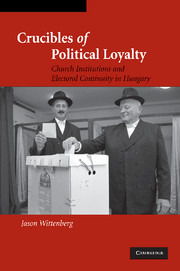Book contents
- Frontmatter
- Contents
- List of Figures
- List of Tables
- Acknowledgments
- INTRODUCTION
- 1 EXPLAINING POLITICAL PERSISTENCE
- 2 ELECTORAL PERSISTENCE AND VOLATILITY IN HUNGARY
- 3 THE CHURCHES FIRST CONFRONT COMMUNISM
- 4 THE BATTLE FOR SOULS, 1948–1956
- 5 THE BATTLE FOR SOULS AFTER 1956
- 6 CHURCH COMMUNITY AND RIGHTIST PERSISTENCE: STATISTICAL EVIDENCE
- 7 CONCLUSION
- Appendices
- Bibliography
- Index
- Titles in the series
7 - CONCLUSION
Published online by Cambridge University Press: 02 September 2009
- Frontmatter
- Contents
- List of Figures
- List of Tables
- Acknowledgments
- INTRODUCTION
- 1 EXPLAINING POLITICAL PERSISTENCE
- 2 ELECTORAL PERSISTENCE AND VOLATILITY IN HUNGARY
- 3 THE CHURCHES FIRST CONFRONT COMMUNISM
- 4 THE BATTLE FOR SOULS, 1948–1956
- 5 THE BATTLE FOR SOULS AFTER 1956
- 6 CHURCH COMMUNITY AND RIGHTIST PERSISTENCE: STATISTICAL EVIDENCE
- 7 CONCLUSION
- Appendices
- Bibliography
- Index
- Titles in the series
Summary
Introduction
Why do mass political loyalties persist even amid prolonged social upheaval, disruptive economic development, and demographic transformation? The paradox of political persistence has bedeviled researchers ever since Siegfried (1913) first identified it. After nearly a century of research there remains little consensus even on how to identify continuity, much less what might account for it. This book has tackled these problems by zeroing in on countries emerging from communism. If there were ever cases in which mass political attitudes should have been transformed, it would have been during state-socialism, when Communist Party dictatorships strove so vigorously to create loyal socialist citizens. Drawing on extensive archival research and an original database of election results, this study has documented and explained the remarkable persistence of rightist partisan attachments during Hungary's journey from multiparty politics to communism and back to multiparty politics in the twentieth century. This chapter first summarizes the book's main findings, and then elaborates on their broader implications.
The microfoundations of rightist persistence are rooted in the power of local institutions, even those under extreme duress, to act as focal points for mutual interaction. Once the Communist Party assumed power, the Churches became the last refuge for those with right-wing loyalties and battled the Party for mass influence for the remainder of the communist period. This epic struggle pitted parish priests and pastors, who encouraged robust religious practice, against Party activists, who sought to restrict church life.
- Type
- Chapter
- Information
- Crucibles of Political LoyaltyChurch Institutions and Electoral Continuity in Hungary, pp. 237 - 246Publisher: Cambridge University PressPrint publication year: 2006

